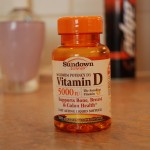I saw two interesting articles this week that made me pause and chuckle a bit. One came from the American College of Physicians' publication, "ACPInternist:" the other from medscape.com as A "Best Evidence Review," and compared and contrasted recent US and Canadian authoritative recommendations." The topics were calcium intake/supplements and Vitamin D optimal dosage and the suggestions varied considerably.. I doubt it's because Canada is further north, but that thought crossed my mind.
So let's talk about calcium first.
In July 2010 an article appeared in the British Medical Journal which made many physicians change their recommendations on calcium supplements. There was nearly 1/3 more heart attacks in a group of patients taking calcium pills as opposed to another group who weren't. At a later revelation at an American medical society meeting, the same group of research scientists showed a data from the Woman's Health Initiative (WHI) that also found a heart risk from calcium supplements, this time both in heart attacks and calcification of coronary arteries.
We quit taking our calcium pills, but continued to drink and eat milk and milk products.
Now other medical researchers have cast doubts on the significance of the data saying the overall WHI statistics showed what is a small heart risk at most. There's still a debate as to whether calcium supplements do or do not decrease hip fractures (a major problem, especially in older women).
Then the Institute of Medicine report issued in November as a joint US-Canadian dictum said most Americans, except possibly for teenage girls and some of the elderly, get enough Vitamin D and calcium without using any supplements and that the major risk of too much calcium intake was really kidney stones. There was a specific caveat that postmenopausal women taking supplements may be getting too much calcium.
Now the January 5th, 2011 Medscape review looked at Vitamin D recommendations in Canada versus those in the United States. Both came from authoritative sources: The Osteoporosis Canada study concluded that many of us are low in Vitamin D and that more is good, mostly in promoting bone health, but possibly in colon cancer prevention and also in decreasing older adult falls. They suggest taking larger doses than the US Institute of Medicine does.
SO...how do I parse these varying studies and what do we plan to do. First, we will continue to get our calcium from food sources, mostly milk, soy milk (with its added calcium), cheese and yogurt. Secondly we'll continue to take a larger dose of Vitamin D in pill form, but perhaps slightly less than we are now, and I may get a little more sun exposure.
One comment in the Medscape article was a "young white person needs approximately 4 minutes of direct exposure to sunlight on the arms and legs to generate approximately 1,000 IU of vitamin D3." There's debate as to using sunscreen or not with a small, but randomized Australian study showing a similar increase in blood levels of Vitamin D, measured as 25-hydroxyvitamin D3 (25-OH-D) whether actual sunscreen was used or a placebo sunscreen. Notice, please, that nobody is suggesting prolonged or facial sun exposure.
I may try some arm and leg skin exposure to sunlight; my wife who has had one skin lesion removed won't. We'll continue taking Vitamin D and she needs a follow-up blood level test as her first one was low. We're now on 5,000 IU per day and that may be too much; the Canadian study suggests 800 to 2,000 IU per day; the US recommendations, while lower (800 IU per day for those 71 and older; we're just shy of that), say risks from too much Vitamin D don't increase until doses are over 4,000 IU per day.
Confusing, isn't it; I suggest you ask your own personal physician as to what you should be doing and also ask them if they've seen the most recent recommendations.




